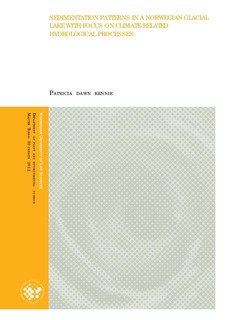| dc.description.abstract | Sedimentation patterns in a Norwegian glacial lake were investigated with focus on climate-related hydrological processes. Three different years with extreme climatic situations were chosen. 1979 had a large magnitude flood with a culmination around 90m3/s and a recurrence interval estimated at 100 years. 2002 had the highest summer temperatures since 1876 and extensive glacial melting. The summer of 2011 had long lasting relatively high rainfall resulting in a long period of high water discharge. These years were compared to a year with extremely low water discharge, 1993, which occurred due to a cold summer and low glacial melt rate.
It was found that large floods and years with long-lasting high water discharge can be recognized by thicker sediment deposits. 1979 had an average thickness of 6.3 mm and 2002 had an average sedimentation of 5 mm whereas 1993 had a thickness of only 2.2 mm. More organic sediments were found in the flood layers, around double of the concentrations found in the sediments deposited in the years before and after. The organic material is washed out from the non-glacial part of the catchment area during rainfall-induced floods. The flood layers contain somewhat larger grain sizes and the sand fraction is deposited especially at distances near the delta front. Throughout the entire lake, it was found that the 1979 layer in four of the cores contained 10-30% more material larger than 31 micron than the 1993 layer. Chemical analyses revealed that the 1979 flood layer contained more Al, Ca, Cu, Fe, K, Mg, Mn, P, S and Zn than the other years, and the higher levels are believed to be caused by the higher surface runoff during the flood. Iron oxides are especially visible when Fe is contained in higher concentrations, and this is a reason why this layer is distinguishable. The sediment trap studies from the period of high transport in 2011 showed lower concentrations of several chemical elements (Al, Cu, Fe, K, Mg, Mn and Na) and more clay and organic material than the cores. This is because many elements are associated with the clay and organic fractions of sediment, and they take a longer time to settle out of suspension, later in the season. The implications for ecology and the use of sediment cores to study changes in climate are discussed. | no_NO |
